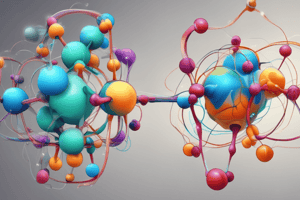Podcast
Questions and Answers
Which of the following is not a type of chemical bond?
Which of the following is not a type of chemical bond?
- Hydrogen bond
- Magnetic bond (correct)
- Covalent bond
- Ionic bond
What is the primary reason for the formation of ionic bonds?
What is the primary reason for the formation of ionic bonds?
- Transfer of electrons (correct)
- Formation of dipoles
- Presence of free radicals
- Equal sharing of electrons
In an exothermic reaction, what happens to the energy?
In an exothermic reaction, what happens to the energy?
- Energy is transformed into mass
- Energy remains constant
- Energy is absorbed from the surroundings
- Energy is released into the surroundings (correct)
Which of the following substances is considered a strong acid?
Which of the following substances is considered a strong acid?
What does the pH scale measure?
What does the pH scale measure?
Flashcards
Molarity
Molarity
The concentration of a solution expressed as the number of moles of solute per liter of solution.
Stoichiometry
Stoichiometry
The calculation of reactant and product quantities in chemical reactions.
Chemical Equation
Chemical Equation
A representation of a chemical reaction using chemical formulas and coefficients.
Balanced Equation
Balanced Equation
Signup and view all the flashcards
Limiting Reactant
Limiting Reactant
Signup and view all the flashcards
Percent Yield
Percent Yield
Signup and view all the flashcards
Acid-Base Neutralization
Acid-Base Neutralization
Signup and view all the flashcards
Redox Reaction
Redox Reaction
Signup and view all the flashcards
pH Scale
pH Scale
Signup and view all the flashcards
Solubility
Solubility
Signup and view all the flashcards
Study Notes
- Chemical Bonding:
- Atoms combine to achieve stable electronic configurations, primarily by filling their valence shells.
- Types of chemical bonds include ionic, covalent, and metallic bonds.
- Ionic bonds form between metals and nonmetals through the transfer of electrons. The resulting ions are held together by electrostatic attraction.
- Covalent bonds form between nonmetals by sharing electrons. These bonds often result in molecules.
- Metallic bonds occur in metals, involving a "sea" of delocalized electrons surrounding positively charged metal ions. This explains the conductivity and malleability of metals.
- Bond polarity arises from differences in electronegativity. Electronegativity is the tendency of an atom to attract shared electrons.
- Bond order describes the number of electron pairs shared between atoms in a covalent bond.
- Bond length is the distance between the nuclei of two bonded atoms, and is related to bond strength.
- Bond energy is the energy required to break a chemical bond.
- VSEPR theory (Valence Shell Electron Pair Repulsion) predicts molecular shapes based on the arrangement of electron pairs around a central atom.
Types of Reactions
- Reactions of Acids and Bases:
- Arrhenius concept defines acids as proton donors and bases as hydroxide ion donors.
- Brønsted-Lowry concept defines acids as proton donors and bases as proton acceptors. This is more widely applicable.
- Lewis concept defines acids as electron pair acceptors and bases as electron pair donors. This is the most broadly applicable definition, extending to many non-proton reactions.
- Acid-base neutralization reactions produce water and a salt. The pH scale measures acidity: a lower pH indicates higher acidity.
- Strong acids/bases completely dissociate in water. Weak acids/bases only partially dissociate.
- Redox Reactions:
- Oxidation involves loss of electrons, and reduction involves gain of electrons. These occur simultaneously in a redox reaction.
- Oxidizing agents cause oxidation; reducing agents cause reduction.
- Oxidation states (numbers) track electron transfer.
- Balancing redox reactions requires oxidation number methodology.
Chemical Equilibrium
- Equilibrium:
- A dynamic state where forward and reverse reaction rates are equal. The concentrations of reactants and products remain constant.
- Equilibrium constant (Kc) quantifies the extent of a reaction at equilibrium.
- Le Chatelier's principle describes how changes in conditions (temperature, pressure, concentration) affect equilibrium. The system shifts to counteract the stress.
Thermochemistry
- Thermochemical Principles:
- Enthalpy (ΔH) is the heat content of a system at constant pressure. Exothermic reactions release heat; endothermic reactions absorb heat.
- Enthalpy changes (ΔH) accompany chemical reactions, and are tabulated for many reactions.
- Hess's law allows calculation of enthalpy changes for complex reactions from simpler reactions.
- Standard enthalpy of formation (ΔHf°) is the enthalpy change for the formation of one mole of a substance from its elements in their standard states. It is used to determine reaction enthalpy from tabulated values.
Energetics of Chemical Reactions
- Energy changes:
- Activation energy (Ea) is the minimum energy required for a reaction to occur.
- Reaction rates depend on temperature and activation energy.
- Catalysts speed up reactions by lowering the activation energy, without being consumed by the reaction.
Solution Chemistry
- Solutions:
- Solutions are homogeneous mixtures of solute and solvent.
- Concentration of solutions can be expressed in several ways like molarity, molality, normality.
- Colligative properties of solutions are affected by the number of solute particles, not their identity. Examples include vapor pressure lowering, boiling point elevation, freezing point depression, and osmotic pressure.
Electrochemistry
- Redox reactions in solution can be used to generate electricity or to drive non-spontaneous reactions:
- Galvanic (voltaic) cells convert chemical energy into electrical energy via spontaneous redox reactions. Electrodes are involved, and a salt bridge.
- Electrolytic cells use electrical energy to drive non-spontaneous redox reactions, and are used for electroplating.
- Standard electrode potentials (E°) define the tendency of a half-reaction to occur.
- Cell potential (Ecell) is the driving force for a redox reaction in a cell; related to standard free energy change (ΔG°) and equilibrium constant.
Nuclear Chemistry
- Radioactivity:
- Radioactive decay involves spontaneous disintegration of unstable atomic nuclei.
- Different types of radioactive decay exist (alpha, beta, gamma).
- Radioisotopes are used for dating materials, medical imaging, and industrial applications.
Studying That Suits You
Use AI to generate personalized quizzes and flashcards to suit your learning preferences.




